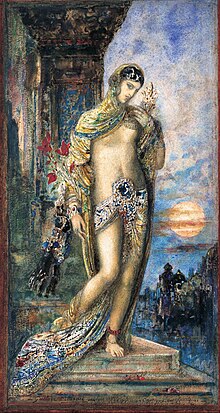
Back Hooglied van Salomo Afrikaans سفر نشيد الأنشاد Arabic ܣܦܪܐ ܕܬܫܒܚܬ ܬܫܒܚܬܐ ARC سفر نشيد الانشاد ARZ Hohes Liad BAR Buku Angka Ende BBC Найвышэйшая песня Саламонава Byelorussian Найвышэйшая песьня Саламонава BE-X-OLD Песен на песните Bulgarian Kanenn ar C'hanennoù Breton
 | |||||
| Tanakh (Judaism) | |||||
|---|---|---|---|---|---|
|
|
|||||
| Old Testament (Christianity) | |||||
|
|
|||||
| Bible portal | |||||

The Song of Songs (Biblical Hebrew: שִׁיר הַשִּׁירִים, romanized: Šīr hašŠīrīm), also called the Canticle of Canticles or the Song of Solomon, is a biblical poem, one of the five megillot ("scrolls") in the Ketuvim ('writings'), the last section of the Tanakh. Unlike most books in the Hebrew Bible, it does not focus on laws, covenants, or divine worship, but instead is erotic poetry, in which lovers express passionate desire, exchange compliments, and invite one another to enjoy.[1]
Modern scholarship tends to hold that the lovers in the Song are unmarried,[2][3] which accords with its near ancient Near East context.[4] The women of Jerusalem form a chorus to the lovers, functioning as an audience whose participation in the lovers' erotic encounters facilitates the participation of the reader.[5]
Marvin H. Pope described the Song as a celebration of sexual love, influenced by ancient fertility rituals, linked to death and liberation, and "suggestive of orgiastic revelry.”[6] Its authorship, date, and origins remain uncertain, with scholars debating its unity, structure, and possible influences from Mesopotamian, Egyptian, and Greek love poetry.
In modern Judaism, the Song is read on the Sabbath during the Passover, which marks both the beginning of the grain-harvest and the commemoration of the Exodus from Egypt.[7] Jewish tradition interprets it as an allegory of the relationship between God and Israel. In Christianity, it is viewed as an allegory of Christ and his bride, the Church.[7][8]
- ^ Alter 2011, p. 232.
- ^ Andruska 2022, p. 202.
- ^ Alter, Robert (2015). Strong As Death Is Love: The Song of Songs, Ruth, Esther, Jonah, and Daniel, A Translation with Commentary. W. W. Norton & Company. p. PT23. ISBN 978-0-393-24305-5.
- ^ Andruska, J. L. (2021). "Unmarried Lovers in the Song of Songs". The Journal of Theological Studies. 72 (1): 1–18. doi:10.1093/jts/flab019. ISSN 0022-5185.
- ^ Exum 2012, p. 248.
- ^ Pope, Marvin H. (1995). Song of Songs. Yale University Press. pp. 24–25, 222. ISBN 978-0-300-13949-5.
- ^ a b Sweeney 2011, p. unpaginated.
- ^ Norris 2003, p. 1.